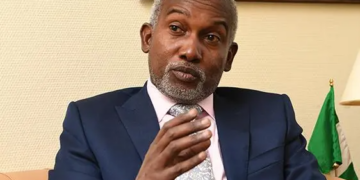Contrary to information by the Nigerian National Petroleum Corporation (NNPC) Limited that the Port Harcourt Refining Company (PHRC) has commenced operations, sources close to the rehabilitation project told
LEADERSHIP Sunday yesterday that it still has some way to go before it is fully operational.
The PHRC is capable of producing 60,000bpd (at full capacity), which, if refined, could yield about 10.1m litres of petrol or roughly one-third of Nigeria’s estimated daily consumption.
The four state-owned decrepit refineries with a combined 450,000 barrels per day, 110,000 barrels Kaduna plant in the north and three units in the oil-rich Niger Delta, including the 125,000 barrels Warri refinery, have been shut for years.
The four local refineries in Nigeria, including Port Harcourt, had stopped operations in 2019, causing problems in the country’s fuel supply.
In August, Senator Heineken Lokpobiri, the minister of state for Petroleum Resources, visited the PHRC and announced that it would start working again by the end of the year.
The federal government had in 2021 approved the sum of $1.5 billion to fix the Port Harcourt refinery.
Subsequently, an Italian company, Maire Tecnimont, was chosen to do the repair work, in three phases. The first phase aims to get the refinery running at 90 per cent capacity within 18 months.
However, sources told LEADERSHIP Sunday that the refinery was hurriedly commissioned with ‘flare start-off’ on
Thursday in Rivers State in order to meet the deadline which Lokpobiri set on behalf of the government in October this year.
The sources and top industry players told LEADERSHIP Sunday that the Port Harcourt refinery was not yet completed.
On Thursday, in a brief ceremony at the refinery, Lokpobiri had announced the “mechanical completion” and the “flare start-off” of the country’s biggest crude refinery during a media tour of the Port Harcourt refinery.
He said: “Just to announce to Nigerians the fulfillment of our pledge to bring on stream phase one of the Port Harcourt refinery by the end of 2023 and the subsequent streaming of phase two in 2024. We happily announced the mechanical completion and the flare start-off on the 20th of December 2023.”
The source said: “Imported Liquefied Petroleum Gas (LPG) was fed into the bottom of the flare to provide fuel, to light the flare instead of the normal flue gas produced from the refinery.
“This action allowed a picture of the flare to be taken, pretending that the refinery had started operations. The picture was taken within a few minutes. The flare was shut down immediately after. The rehabilitation work was not completed! That cannot happen in the foreseeable future.”
Another top official of NNPCL in the refinery told LEADERSHIP Sunday: “The Port Harcourt refinery cannot make any products in the foreseeable future, because the units cannot take in crude oil for processing. The rehabilitation work has NOT been completed. The federal government and NNPC know this truth but will not admit it publicly. In fact, no crude oil has been supplied to the refinery to date, for the same reason.”
Another senior official said: “Look at the flare! Look at the crude cargo! Look at the inspection visits! All meaningless.”
But the oil minister Lokpobiri said the ceremony heralds the commencement of production of petroleum products after the Christmas break.
He thanked Nigerians for their patience and trust in the NNPC to deliver on its promise and mandate of rehabilitating the refineries.
“This is also another landmark of the Renewed Hope Agenda of President Bola Ahmed Tinubu’s administration. Congratulations to NNPC and congratulations to Nigerians,” he stated.
The chairman of Board of NNPC Limited, Pius Akinyelure, on his part had expressed satisfaction about the new development.
Akinyelure said his team had promised President Tinubu that the refinery would begin operations in 2023.
He recalled that the refinery had undergone several phases of rehabilitation, noting that the commencement of operations would keep fuel costs stable.
All efforts to get information from the Italian company, Maire Tecnimont yesterday were abortive as emailed enquiries sent to the media consultant of the company were not responded to at the time of going to press.
However, responding to LEADERSHIP Sunday’s enquiries, chief corporate communications officer, NNPC, Olufemi Soneye, said that over the past month, NNPC Ltd had released a three-part documentary detailing completed works, equipment installation, and mechanical completion of the Port Harcourt Refinery.
“It’s crucial to note that the Old Port Harcourt Refinery (OPHR) being rehabilitated is 60,000 barrels per day, not 210, 000. The NNPC has communicated that the mechanical completion phase will be ready by December. The remaining steps include testing lines, checking for leaks, blowing and drying lines, flushing, steam out, equipment calibration, and then introducing hydrocarbons. Testing for air in the lines is vital to prevent potential explosions, aligning with global best practices.
“While eagerness exists to complete the project, it’s essential for NNPC Ltd, as a global energy company, to conduct all necessary checks and testing,” Soneye said.
Commenting on the developments, general secretary, Petroleum and Natural Gas Senior Staff Association (PENGASAN), Lumumba Okugbawa, said the refinery was still undergoing test running, adding that Nigeria should be happy that something is happening to the refinery after many years of abandonment.
“They can cut the tape. Work is still ongoing in the refinery. In the refinery, there will be a calibration test, and other test-runs. The refinery will come up fully for production after all test-runs have been completed, hopefully by first quarter of next year.
“Nigeria should also note that the coming up of the refinery will not automatically crash the price of fuel in Nigeria. Fuel from the refinery will be sold at international price,” he stated.
We’ve got the edge. Get real-time reports, breaking scoops, and exclusive angles delivered straight to your phone. Don’t settle for stale news. Join LEADERSHIP NEWS on WhatsApp for 24/7 updates →
Join Our WhatsApp Channel










